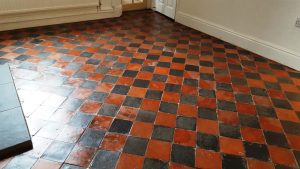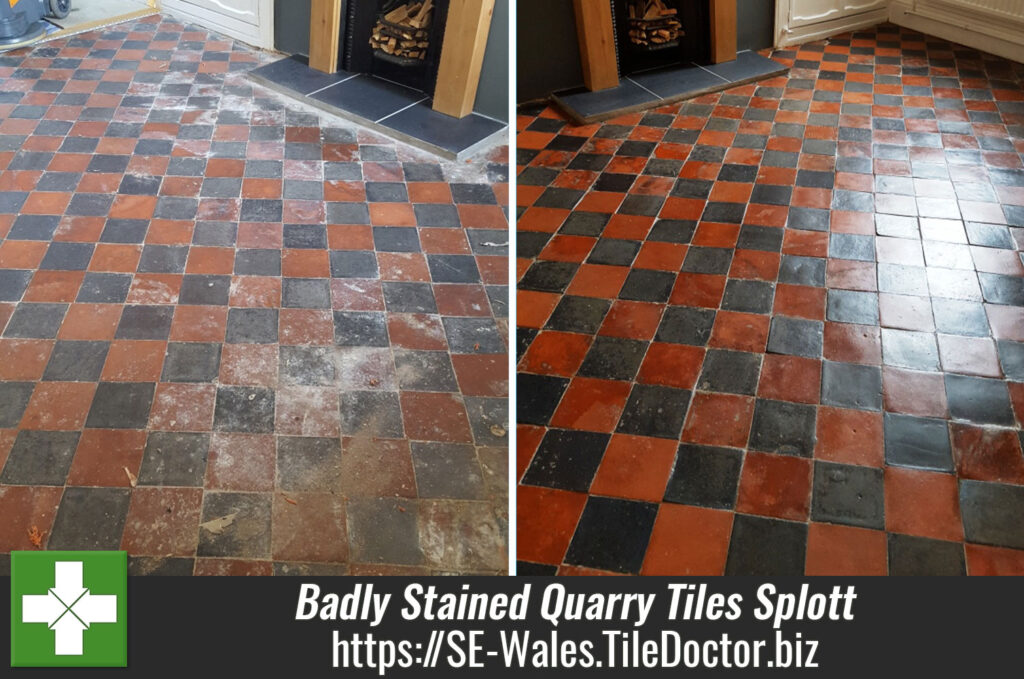These Quarry tiles at a house in Splott, a small town not too far from the city of Cardiff, had certainly endured a hammering after what appeared to be recent decoration in the room. The tiles were heavily soiled, with sand and cement mixed up and splattered across the floor, along with deep paint and plaster stains.

The customer had already scraped off as much of the cement and other stubborn stains off – as much as they could, at least. Quarry may be typically hard wearing, but this doesn’t necessarily mean it’s any easier to clean when it gets into a bad way. Eager to find a solution to the problem, the customer found Tile Doctor via the Internet, and not long after we arranged for me to come down to the property to see what could be done.
 |
 |
| Quarry Tiles Before Restoration in Splott Cardiff | |
Upon arriving at the property and giving the tiles an initial inspection, I explained that not all stains and marks will come off or out of the tiles, as some staining is simply permanent. Nonetheless, the customer indicated they would be satisfied with any improvement made to the condition of the floor. Having restored tiles similar to these before, I knew that the results could still come off very well using the right methods and products.
Cleaning a Stained Quarry Tiled Floor
To begin I mixed a strong solution of Tile Doctor NanoTech HBU and Pro Clean, a combination of two different cleaners. Pro Clean is a versatile, high alkaline cleaner that is used to deal with reasonably heavy soil build-up on natural stone floors. It also contains stripping properties that allow it to start breaking down any old sealers when left to dwell on the tiles. NanoTech HBU takes the cleaning process a step further: it is specially formulated to use nano-sized cleaning particles to reach dirt and stains deeply ingrained in the stone, before dissolving and lifting them out.
This solution was applied to the floor and, working in small sections, I scrubbed it into the tiles using a rotating scrubbing machine fitted with a nylon brush attachment. The floor was then rinsed, and the resulting cleaning slurry was vacuumed away using a wet-vax machine.
My next concern was the grout, which was afflicted by stubborn cement marks. I opted to remove these firstly by carefully applying Tile Doctor Grout Clean Up, an acid-based cleaner. Some cement marks remained despite the application, and so I attempted to manually scrape and chisel them away. While I had some good success, as mentioned not all cement stains can be removed, especially if they have been there for a long time. Some old cement mixture is as hard as flint!
Sealing a Quarry Tiled Floor
I left the floor to dry following the clean and came back two days later to seal the tiles, checking first that they were dry by taking multiple readings with the damp meter, and comparing them with earlier results.
The test results came back fine, so I started with the lengthy task of applying eight coats of Tile Doctor Seal and Go sealer. Having sealed similar floors with Seal and Go before I knew the results would be very desirable, with the deep natural colours in the stone being enhanced by the product. Seal and Go is my preferred sealer for Quarry tiles as it helps disguise some permanent marks and adds a durable satin shine finish.

While unfortunately a stained floor like this will never be able to look good as new, the results I managed to achieve were very pleasing. Certainly there was no evidence left of recent decoration, with the vast majority of the stains and marks no longer damaging the appearance of the tiles. The fresh seal has really brought out the red and black checked pattern in the floor. Needless to say the customer’s expectations were exceeded!
 |
 |
| Quarry Tiles After Restoration in Splott Cardiff | |

